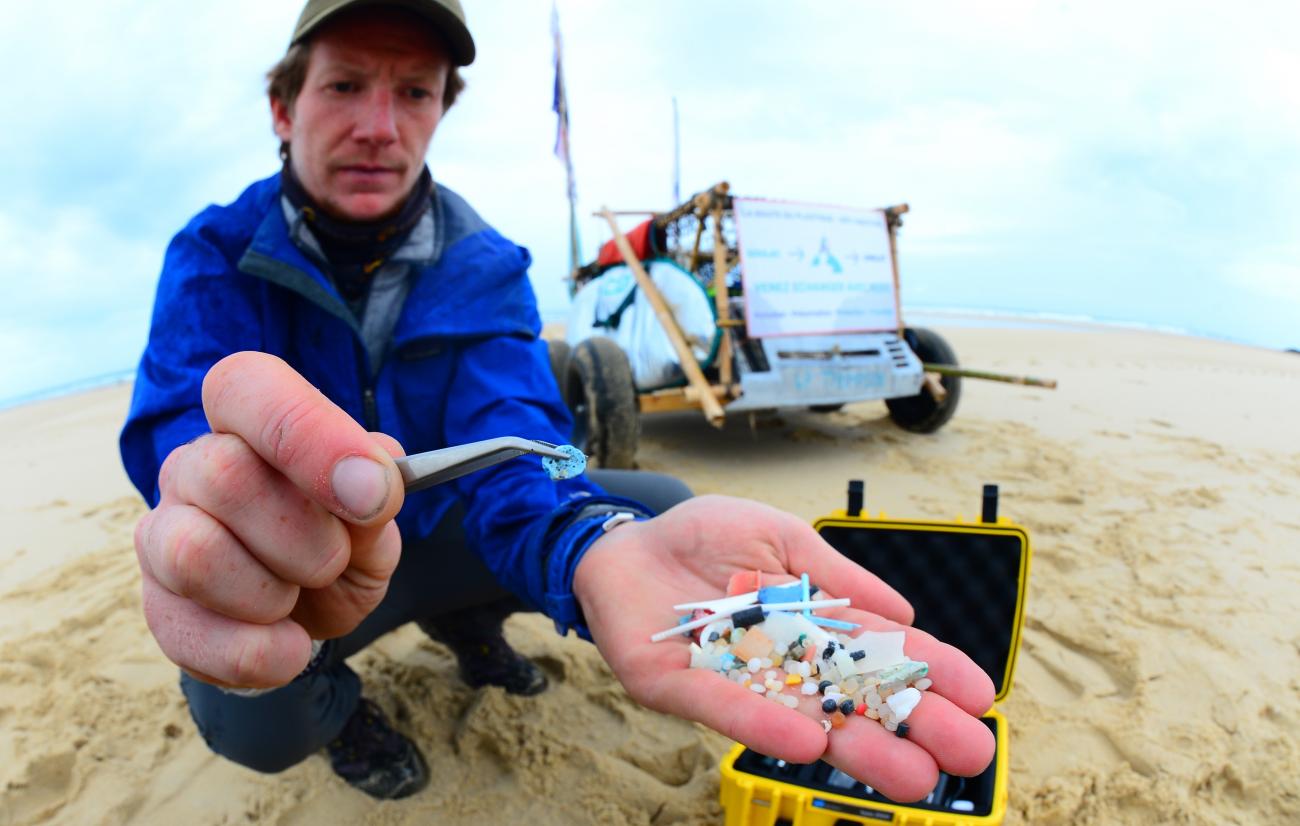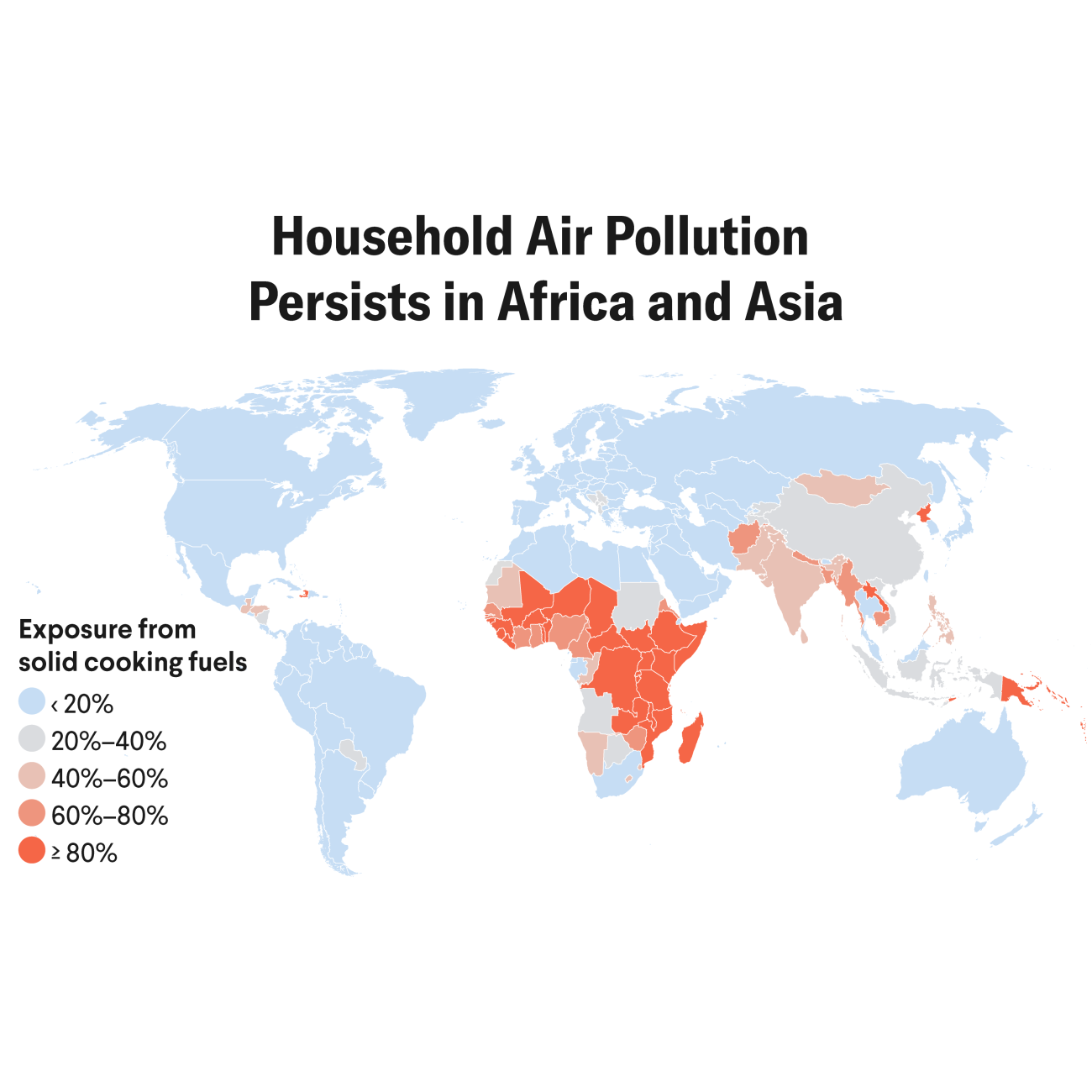Plastics of all shapes and sizes have increasingly polluted our planet since the mid-twentieth century, affecting both natural and urban ecosystems. As a result, global plastic pollution now ranks second to climate change as a serious environmental health threat.
Microplastic pollution—solid plastic particles and fibers measuring 5 millimeters (mm) in size or smaller—occurs due to weathering and degradation of commonly used plastic objects, such as toys, tools, furniture, automotive tires, clothing, paint coatings, and the loss of industrial pellets, flakes, and powders. Microplastics are also added to a range of cosmetics and cleaning products that can end up in the environment. As a result, there are increasing reports of microplastic contamination in drinking water, milk, food, and air. Indoor air and dust, in particular, are significant sources of microplastic contamination. People may also consume high plastic particle loads from microwaved or heated food containers, bottles, and plastic tea bags. In turn, we are constantly swallowing and inhaling microplastics.
Global plastic pollution now ranks second to climate change as a serious environmental health threat
Although scientists have found microplastics in the bodies of many animal species worldwide, there is little evidence that they exist in humans' organs and bodily fluids. The analysis of microplastics in people is still in its infancy, and the latest discovery of plastic particles in the whole blood of human donors made headlines, as expected. There have also been reports of plastic fibers and fragments in human feces, deep inside human lungs, colons, and placentas.
It is well established that children constitute one of the population groups at greatest risk for environmental contaminants. One reason is because proportionally per kilogram of weight, children eat more food, drink more liquids, and breathe more air than adults. Recently, scientists found that babies have more plastic particles in their feces than adults, suggesting that they may also be more vulnerable to microplastics.
Detecting Microplastics in the Body
The search for plastic particles in human matrices has only just begun, and the full extent of that exposure and what microplastics are doing in our bodies is still poorly understood. Detecting and quantifying microplastics in the human body is a complex task. First, researchers need to adopt strict quality control measures to prevent potential contamination of samples. Second, there is no suitable analytical technique for the full range of plastic particles in environmental or biota samples. Current methods primarily focus on the micro-and sub-micro particle fraction. For example, scientists analyzing human blood, as mentioned above, only measured particles between 1.5 mm and 700 nanometers (nm, or 0.0007 mm). Ideally, scientists should use a combination of techniques, including spectroscopic and spectrometric methods, to quantify and characterize plastic particles, and such combined procedures are still under development.
Because of the constraints to measuring smaller microplastics (also termed nanoplastics) and measurement bias toward larger particles, existing analyses do not provide a complete picture of exposure to plastic particles and the accumulation inside the human body resulting from lifetime exposure. Only the tip of the iceberg is visible now in terms of our understanding. However, because of their small size, nanoplastics can pass through biological membranes more easily—making them more deserving of special attention. Researchers do not know the effect of plastic particle pollution on our health. However, public health concerns are rising as microplastic pollution increases and its actual dimension unravels.

Microplastics Unmasked
Microplastics are a diverse class of contaminants spanning five orders of magnitude and they come in various sizes, colors, shapes, and compositions. They are made of different polymers and plastic additives that can have toxic properties, including certain monomers, bisphenol A and phthalates. When released into the environment, microplastics become coated with biomolecules, micro-organisms, and chemical contaminants such as polycyclic aromatic hydrocarbons (PAHs), organochlorine pesticides, and other substances that can affect the particles' absorption, fate, and toxicity. In addition, the properties of microplastics and the composition of the surface layer of the particles can change depending on environmental conditions and age. After exposure and possible bioaccumulation, microplastics can cause physical, chemical, and microbiological effects, which can also act cumulatively.
Possible Health Effects of Microplastics
Most concern is related to the physical effects, the so-called particle toxicity, especially of the very small particles. The body does not break down microplastics. Therefore, when plastic particles enter the body through food or the lungs and come into contact with mucous membranes or become internalized, they are engulfed by immune cells (phagocytes), which trigger continual activation of the immune system and do not affect the particles themselves. This activation results in various adverse effects, including oxidative stress and the release of multiple cytokines that trigger inflammatory reactions with the potential to cause chronic inflammation. Ultrafine particulate air pollution has been linked to millions of premature deaths worldwide. The smallest particles (<100 nanometer) penetrate deep into the lungs and even into the bloodstream, causing damage to blood vessels, the heart, and the brain. Researchers begin to understand that a small—but probably increasing—fraction of fine particulates in air consists of microplastics and so, likely contributes to this crisis.
The only direct evidence of adverse health effects comes from workers in the textile and plastics industries. Workers in these industries had been exposed to pristine plastic fiber dust in large quantities. As a result, some developed inflammatory and allergic respiratory diseases and even cancer. However, these results are difficult to extrapolate to real-life exposures and the general population.
Scientists have found microplastics in many animal species worldwide, but the analysis of microplastics in people is still in its infancy
A Growing Body of Indirect Evidence
Nonetheless, there is a mounting body of indirect evidence. For example, increasing numbers of experimental studies with aquatic animals and rodents indicate the translocation of tiny plastic particles from the gills, lungs, and gut cavity to the circulatory systems, causing systemic exposure and accumulation in several tissues. These studies indicate that tiny plastic particles can cause inflammatory and immune reactions, DNA damage, and other adverse health effects. In addition, new evidence from Dutch and other studies with human cell models (outside the body) shows that tiny plastic particles can cross the intestinal wall, the lungs, the placenta, and the blood-brain barrier. In these experiments, plastic particles impaired brain and placenta cell function and alveoli development. In addition, in various tissues, inflammatory responses were seen. In vitro and in vivo animal studies indicate potential health risks but are challenging to translate to humans and real-world exposures.
Plastic particles themselves can contain and release toxic chemicals, including additives and contaminants adsorbed to them, such as previously mentioned. Microplastics leaching these hazardous chemicals inside the body can cause endocrine disruption and reproductive, developmental, and other harmful effects. A wealth of scientific evidence supports this for large plastic items. However, whether microplastics bring these chemicals into the human lungs, placenta, or other organs is still under investigation.
Research suggests that the corona on a plastic's surface can be a carrier as well, introducing pathogens into the body that can increase the risk of infection. Plastic particles could also act as a breeding ground for antimicrobial resistance, disrupt the gut microbiome, and theoretically, plastic aerosols could spread the COVID-19 virus. Studies are currently underway to test these hypotheses.
Knowledge Gaps and Burning Questions
For this field to advance significantly, three crucial knowledge gaps should be addressed. How much plastic is in the body and where does it go? Are the plastic particle doses in blood and tissues sufficiently high enough to trigger or mediate responses leading to diseases? This information is crucial for an adequate risk assessment. Researchers also need a better understanding of the interaction of plastic particles at the cellular and tissue levels, and to discover the role of the changing properties of the particles influencing their fate and toxicity. Eventually, we need to know how plastic particles differ from other ambient particles. Do they have a unique toxicological profile given their persistence, wide size range, and complex nature? Finally, how much do plastic particles contribute to total particle burden and global mortality and disease burden? Especially in unborn infants and children who are in theory, more at risk from (micro)plastic pollution because their body systems, including their immuno-surveillance system, are still developing.
Recently the European Union, public authorities, industry, and nonprofit organizations launched new multidisciplinary research initiatives and consortia to answer some of these questions. The strength of these projects is primarily due to the collaborative efforts of several disciplines, including toxicologists, polymer chemists, and medical and public health experts. However, there is no time to lose with increasing plastic production and increasing evidence of a global threat to public health. Due to the complexity of the research required, a comprehensive risk assessment for plastic particles is still a long way off.
All plastic produced and left in the environment will eventually degrade into nano-sized plastics, worsening plastic particle pollution over time
Microplastic Pollution Will Only Increase
The degradation of plastics is a ticking time bomb, especially as plastic production and consumption continue to increase. All plastic produced and left in the environment will eventually degrade into nano-sized plastics. As a result, plastic particle pollution is inevitable and will only worsen over time. Furthermore, it leads to an ever-increasing risk of microplastic inhalation and ingestion on a global scale. So, people should weigh their current limited scientific understanding against this bleak future scenario. Meanwhile, we need to take the precautionary approach and tackle microplastic pollution as part of a bigger story.
Microplastics Are Part of A Bigger Story
There is a wealth of evidence that plastic pollution—including significantly larger plastic items—affect our health and are related to local or global disease burden, mortality, and socio-economic costs. There are plenty of examples. Open burning of plastics causes the release of toxic chemicals that cause respiratory disease and even death. Obesity, poor fetal development, and early death are associated with endocrine-disrupting chemicals in household products. The environmental and human health risks are increasing due to the increased pressure of chemicals and particles. Plastics have a substantial and increasing share in this. Therefore, one way forward is a One Health approach to the effects of plastics to protect human health. Plastic debris of all sizes can affect the health of animals, plants, and ecosystems. Humans and other living organisms share only "one" health, and what affects one affects all three. To protect our health, we must protect the health of plants and animals. In addition, microplastics and plastic waste could theoretically alter habitats and interfere with essential ecosystem functions involving ecosystem services that could impact human health. These possible indirect effects deserve much more attention and research.
The Time is Now
Society urgently needs a system change, including policy changes on plastics, but this will not happen overnight. Consumers and corporations must identify and stop production of unnecessary and harmful plastics. We need to reduce the amount of plastic in the system and design safe plastics or alternative materials applying to the circular economy. Collaboration between disciplines is crucial to reducing plastic pollution. Scientists, researchers, and policymakers need to look for linking factors of plastic pollution with other global health crises, including air pollution, biodiversity loss, and climate change and global warming (for example, plastic accounts for 4.5 percent of global greenhouse gas emissions in 2015). Instead of competing, decision makers should complement each other. Working together will create synergistic actions to help reduce the plastic pollution crisis. Society cannot accept that certain companies' profit or economic growth is more important than our health and a sustainable and safe future for the next generations. Children and society are becoming more disconnected from nature and its services. We must educate and set an example for our children to protect the planet. To save our health and the health of future generations, we believe this is crucial to help fight the plastic pollution problem as a public health emergency.





